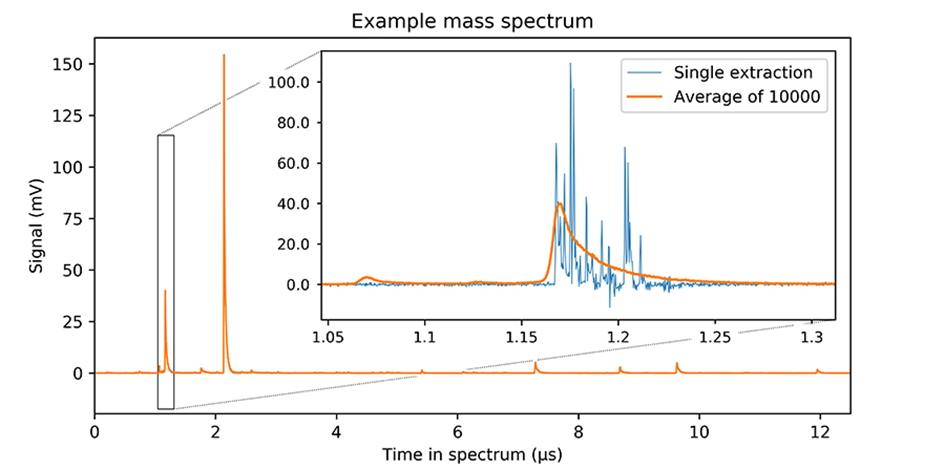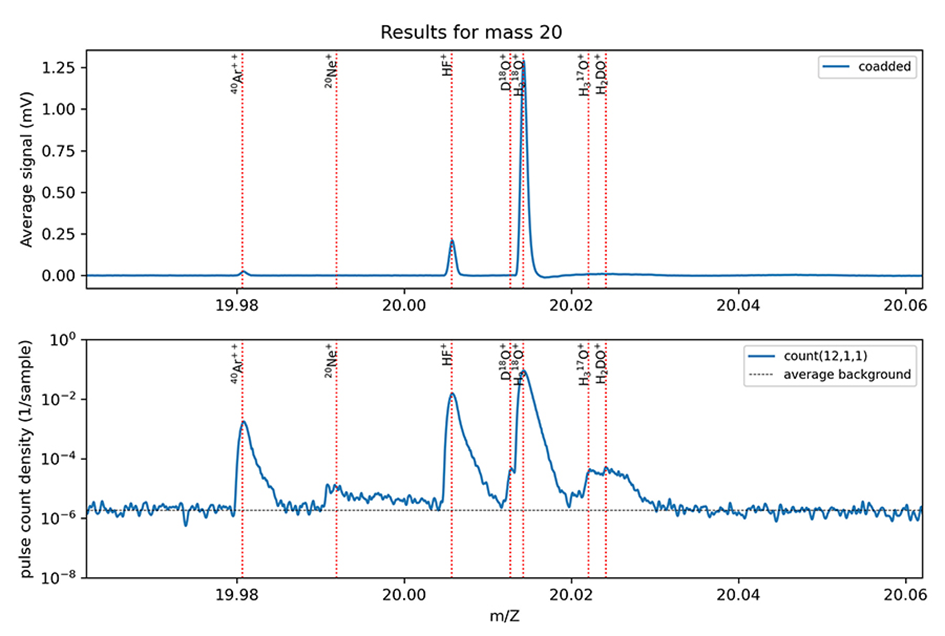Background
The MASPEX instrument is a high-resolution time-of-flight mass spectrometer for planetary missions developed by SwRI’s Space Science and Engineering Division. MASPEX operates by ionizing ambient gas in an ion source and extracting clouds of sample ions from the source into an analyzer region. In the analyzer the ions separate by mass before hitting a detector where the ion current is amplified by a multi-channel plate (MCP) stack and collected on an anode, producing a voltage signal. A high-speed ADC digitizes the voltage signal. To improve signal-to-noise, the entire sequence of ion extraction, mass separation, and detection is repeated thousands of times. Storage and transmission of the thousands of single-extraction spectra are infeasible, so MASPEX coadds (essentially averages) to produce one resulting spectrum for each mass range being analyzed. These co-added spectra are the primary data product of MASPEX. Coadding is appropriate for high abundance ions because the peak area is always proportional to the number of ions. However low abundance ions with fewer than one ion per extraction on average, such as ions with rare isotopes, are difficult to detect with coadding because of the accumulated noise of the ADC. However, these rare ions can be seen in the single-extraction spectra before coadding, so a change in processing algorithm may be able to increase the instrument’s sensitivity and dynamic range.
Approach
The Multi-bounce Time of Flight 5 (MBTOF-5) has ion optics nearly identical to MASPEX and a signal acquisition system capable of digitizing and storing the thousands of single-extraction spectra. A data set of spectra including low abundance ions was recorded using this instrument, allowing different processing techniques to be compared in post-processing. The most promising technique is to record a count spectrum in addition to the coadded spectrum. The count spectrum is created by defining a threshold above the noise of the ADC and counting individual ion pulses that rise above this threshold. The coadded spectrum is still required because for high abundance ions, single ion pulses overlap and cannot be accurately counted.
Accomplishments
Ions randomly scattered through the spectrum form a diffuse ion background which is the dominant noise source after the ADC noise is effectively removed by ion pulse counting. Adjustments to the ion source and improved techniques of controlling the ion optics reduced this noise by a factor of 10—100. A data set covering the m/z range from 16 through 21 was then recorded and post-processed. Using the combined counting/coadding technique, the dynamic range of the instrument was increased to over 106. This was accomplished using processing techniques within the capabilities of the current MASPEX instrument. Some measurements of rare isotope peaks were made with isotopic ratios within the expected ranges. However, strong conclusions cannot be made regarding the accuracy of these ratios since the measurements were not made with a calibrated sample gas. Application of the analytical procedures developed in this project to standardized samples is an important step in future work.

Figure 1: Example of a mass spectrum.

Figure 2: Mass spectrum for ions with m/z=20. The top spectrum is the coadded spectrum and the lower spectrum is the count spectrum.
